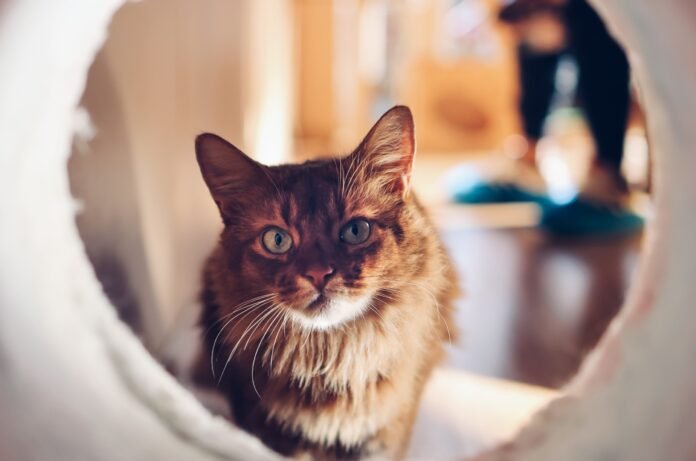Litter Robot 4, often referred to as the Litter-Robot 4 Connect, is the latest upgrade in a series of automatic, self-cleaning litter boxes from the company Auto Pets. It’s an advanced solution for cat owners, designed to offer maximum comfort for pets while ensuring cleanliness and convenience for their human caregivers.
Equipped with state-of-the-art technology, the Litter Robot 4 boasts numerous features that make pet care effortless and efficient. Its spacious and comfortable litter chamber automatically separates waste from clean litter, depositing the waste into a concealed drawer for easy disposal. This entire process is sensor-driven, ensuring that the cleaning cycle activates only after your cat has exited the unit. What sets Litter Robot 4 apart from its predecessors and competition is its advanced connectivity. It can be seamlessly integrated with your home’s Wi-Fi network, allowing you to monitor and control it through a mobile application, regardless of your location.
Table of Contents
There are two main sensors in the Litter-Robot – the Curtain Sensor and the Weight Sensor.
The Curtain Sensor is strategically placed to look down across the opening of the unit and into the Globe. Its purpose is to detect when a cat enters or exits the Globe while it’s in its Home position. If this sensor is activated during a cycle, it will stop the Globe’s rotation. If there’s no further activation for 15 seconds, the Globe will then continue to rotate. If you notice your Litter-Robot isn’t cycling, it may be worthwhile to inspect the Bezel for any debris, such as cat fur or dust, which could be obstructing the Curtain Sensors. If this is the case, you can usually fix the issue by wiping the Bezel and the Curtain Sensor holes with a dry towel.
Also read: From Purchase to End-of-Life: A Deep Dive into the Lifespan of a Litter Robot
The Weight Sensor, on the other hand, is situated in the base of the unit. It’s tasked with further detecting and measuring the cat’s weight while the Globe is in its Home position. If additional weight is detected during a cycle, similar to the Curtain Sensor, the Globe will stop. After 15 seconds of no further weight detection, the rotation will resume.
Each time you power ON the unit or complete a cleaning cycle, the Weight Sensors measure the unit’s weight to use as a baseline or “zero” value. This measurement can be manually reset at any point by pressing the Reset button.
Understand the Litter Robot 4 Cat Sensor Fault
Despite its technological sophistication, like any mechanical device, the Litter Robot 4 can encounter issues – one common problem being the cat sensor fault. This issue can lead to ineffective cleaning cycles, and at worst, can cause the unit to cease functioning entirely. Understanding this fault and how to resolve it is crucial for ensuring the longevity and effectiveness of your device.
The cat sensor is a critical component in the Litter Robot 4’s operation. It detects when your cat enters or exits the device, initiating the cleaning cycle only after your pet has safely left the litter box. When this sensor malfunctions, it may fail to detect your cat’s presence, leading to irregular cleaning cycles, or it may not function at all.
How do you decode and resolve an in your Litter Robot 4 cat sensor fault?
Identification
The first step is to identify the fault. The Litter Robot 4 is designed to communicate issues to its user. In case of a cat sensor fault, the device’s control panel will flash a yellow light to alert you of the problem.
Also read: Dealing with Pinch Detect Faults Litter Robot
Fundamental Diagnostic Steps
Before attributing the issue to a faulty sensor, it’s vital to undertake some fundamental diagnostic steps. First, verify that the Litter Robot 4 is securely connected to a working electrical outlet and is turned on. At times, a minor technical issue can be resolved through a simple power reset. To do this, disconnect the device from the power source, let it rest for a few minutes, then reconnect it. Monitor if the sensor fault light still flashes after restarting.
Examination for Physical Obstructions
A malfunctioning sensor can sometimes be traced back to a physical obstruction. Thoroughly examine the globe for any accumulation of litter clumps or foreign objects that might be obstructing the sensor’s path. Moreover, ensure that the litter level within the unit is balanced – an excess or deficiency of litter can impact the sensor’s ability to function optimally.
Thorough Sensor Cleaning
Accumulated dirt or debris on the sensors can be a potential cause for malfunction. Employ a soft, dry cloth to delicately wipe down the sensors. It’s essential to avoid the usage of harsh or abrasive cleaning agents, as these could inflict damage upon the sensitive components of the device.
Device Reset
If the sensor fault continues despite your troubleshooting efforts, it might be necessary to reset the unit. This can be accomplished via the Litter Robot’s dedicated mobile application, or manually by long-pressing the reset button located on the control panel. Keep holding until the indicator light transforms to a blue color, signaling a successful reset.
Also read: How to Reset Your Shark Robot Vacuum for Optimal Functioning
Enlist Professional Assistance
In the event that all other strategies fail to rectify the issue, it would be prudent to contact AutoPets’ customer service. Their trained professionals can offer guidance through more intricate troubleshooting steps and if necessary, coordinate the process for device repair or replacement. Rest assured that they are committed to resolving your issue and ensuring your Litter Robot 4 resumes normal functionality.
Conclusion
While the Litter Robot 4’s cat sensor fault can be a frustrating issue, it’s generally a problem that can be solved at home with some simple troubleshooting steps. Regular cleaning and maintenance of your Litter Robot 4 will also go a long way in preventing such issues from occurring in the first place. Always remember that the key to a well-functioning device is its well-informed and diligent owner.
Frequently asked questions (FAQs)
1. Q: What does it mean when the Litter Robot 4’s control panel flashes a yellow light?
A: A yellow light flashing on the control panel is an indication of a fault, specifically the cat sensor fault. This means that the sensor is failing to detect your cat’s presence correctly, potentially leading to irregular cleaning cycles or the unit not functioning at all.
2. Q: How can I troubleshoot a cat sensor fault in my Litter Robot 4?
A: Begin with basic troubleshooting. Ensure the device is plugged in and turned on correctly. Check for any obstruction in the globe that might be blocking the sensor. If the issue persists, clean the sensor using a soft, dry cloth and reset the unit either manually or via the Litter Robot’s mobile application.
3. Q: What role does the Curtain Sensor play in the Litter Robot 4, and how can I maintain it?
A: The Curtain Sensor detects when a cat enters or exits the Globe while it’s in the Home position. If your Litter-Robot isn’t cycling, it could be due to debris obstructing the Curtain Sensors. Wiping the Bezel and the Curtain Sensor holes with a dry towel usually rectifies this issue.
4. Q: What is the purpose of the Weight Sensor in the Litter Robot 4, and how do I manage it?
A: The Weight Sensor, located in the base of the unit, helps detect and weigh the cat in the Globe. If additional weight is detected during a cycle, the Globe will stop. You can reset the Weight Sensor by pressing the Reset button whenever there’s a change in the unit’s weight.
5. Q: What happens if the cat sensor fault persists even after following the troubleshooting steps?
A: If the cat sensor fault continues even after you’ve tried troubleshooting, it’s time to reach out to AutoPets’ customer support. They can guide you through more advanced troubleshooting procedures or arrange for repair or replacement if necessary.
6. Q: How can I prevent the Litter Robot 4’s cat sensor fault from occurring?
A: Regular cleaning and maintenance of your Litter Robot 4 can prevent sensor faults. Ensure the litter level is appropriate, regularly clean the sensors, and keep the unit on a hard, level surface for the accurate functioning of the Weight Scale.

